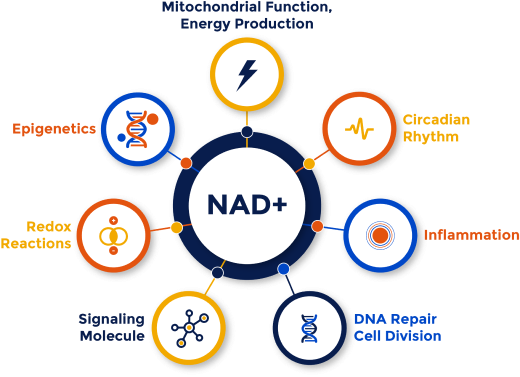Revolutionizing lifestyle medicine, aging related disorders and rare disease through a new class of oral NAD+ therapeutics
BNAD101: Oral solid dose NAD+ therapeutic clinically proven to rapidly increase intracellular NAD, specifically developed to address the multifaceted nature of neurological diseases
Bryleos is a woman-owned and women-led company dedicated to making significant advancements in the treatment of multifactorial neurological diseases. Moving beyond traditional single-target drug models, BNAD101 is engineered to modulate a circumscribed set of pathways with a known role in the pathogenesis of neurodegenerative diseases. The dysregulation of these pathways is common across different neurodegenerative diseases (in particular ALS, PD, MS, SUD) and highlights the fundamental link between impaired cellular metabolism and neuroinflammation.
Lead asset, BNAD101, increases intracellular NAD
Our innovative, proprietary LathMize™ technology has facilitated the development of our lead asset, BNAD101, directly replenishing cells with NAD+, bypassing intermediates like NMN and NR. BNAD101 shows promise as a treatment for reducing aging related disease, chronic and rare diseases, and enhancing longevity in aging medicine. BNAD101 achieved a 52% increase in intracellular NAD levels compared to placebo, showing potential in modifying pathways linked to neurodegenerative diseases. BNAD101 targets crucial factors including oxidative stress, mitochondrial dysfunction, and the regulation of glutamate to avert neurotoxicity.
What is NAD?
NAD is a pivotal molecule governing crucial aspects such as mitochondrial function, oxidative stress, enzyme activity, DNA repair, inflammation, and a multitude of costly chronic diseases. For over a century, the immense potential of NAD+ has remained untapped in therapeutics. This is primarily due to its inherent chemical instability, rapid degradation in the gut, and limited bioavailability.

Why NAD Matters
NAD is found in every cell in the human body and is essential for creating cellular energy and maintaining healthy cell function. NAD declines with age and is a central factor in the aging process. Depletion of NAD levels is a key feature in multiple chronic diseases, especially those related to oxidative stress, mitochondrial dysfunction and glutamate toxicity.

Current approaches to increasing NAD have limitations


NAD precursors NR and NMN are designed to increase NAD levels over time
- High interindividual variability in conversion rate
- Delayed onset of therapeutic effect
- Limited role in pharmacotherapeutics
- More applicable to optimizing wellness vs treating disease


IV NAD+, while fast-acting, is not practical or scalable
- Chemically unstable
- Made at a compounding pharmacy
- No IP – lack of clinical studies means it will never become the standard of care
- Expensive and time-consuming: when used as treatment, high doses must be delivered over multiple days
BNAD101 increases intracellular NAD

For NAD to have biological activity, it must enter the cell
- BNAD101 rapidly and significantly increases intracellular NAD by 52% within 5 days of oral administration compared to placebo
- Most studies of current NAD precursor products rely on extracellular, circulating NAD measurements or surrogate metabolic markers, such as degradation products in blood and urine as proof of efficacy


Day 11=Day 4 on treatment.
Day 13=One day post-treatment.
Demonstrated
proof-of-concept
Proven increase in intracellular NAD with BNAD101 vs placebo (P=4.13×10-13)
In 2022, Bryleos successfully completed a randomized clinical trial (N=60) demonstrating proof-of-concept in healthy adults.
- Levels of NAD+ in cells increased rapidly and significantly
- 52% increase in just 5 days
- Well tolerated; favorable safety profile
BNAD101 innovation is a catalyst for growth


BNAD101: Pipeline in a drug
The exploratory endpoints of the proof-of-concept study looked at proteomic and metabolomic markers, as well as clinical chemistries at baseline and following 5-day administration.
Statistically significant differences in proteins and metabolites between BNAD101 and the placebo group were observed in additional key areas:

Neurodegenerative and neuropsychology

NAFLD/NASH

Metabolic

Cardiovascular
BNAD101: Pipeline in a drug
The exploratory endpoints of the proof-of-concept study looked at proteomic and metabolomic markers, as well as clinical chemistries at baseline and following 5-day administration.
Statistically significant differences in proteins and metabolites between BNAD101 and the placebo group were observed in additional key areas:

PRIORITY #1: Age related and rare neurodegenerative diseases
BNAD101 Hypothesis: A systems approach that modulates a set of interconnected pathways (as opposed to highly isolated targets) has the potential to demonstrate high clinical efficacy in treating these costly neurological disorders
- Oxidative stress
- Due to excessive production or reduced clearance of Reactive Oxygen Species (ROS); DNA and cellular damage, and associated cellular stress responses
- Mitochondrial and proteosomal dysfunction
- Due to misfolded mitochondrial proteins, excessive energy demands due to demyelination, or altered mitochondrial dynamics (biogenesis, fission/fusion); endoplasmic reticulum stress
- Glutamate homeostasis and glutamate-induced excitotoxicity
- Due to impaired amino acid metabolism and accumulation of intracellular and mitochondrial Ca that leads to increase ROS production and apoptosis
BNAD101 has the potential to serve a significant global market, bridging a material gap across all patient needs

Fearlessly committed to changing how the world thinks about costly chronic diseases
Want to change the world? Let’s connect.